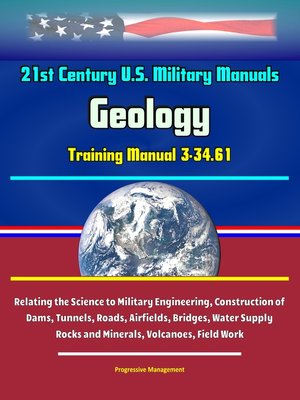21st Century U.S. Military Manuals
ebook ∣ Geology Training Manual 3-34.61--Relating the Science to Military Engineering, Construction of Dams, Tunnels, Roads, Airfields, Bridges, Water Supply--Rocks and Minerals, Volcanoes, Field Work
By Progressive Management

Sign up to save your library
With an OverDrive account, you can save your favorite libraries for at-a-glance information about availability. Find out more about OverDrive accounts.
Find this title in Libby, the library reading app by OverDrive.



Search for a digital library with this title
Title found at these libraries:
| Library Name | Distance |
|---|---|
| Loading... |
This important U.S. Army document, Geology Training Manual 3-34.61, has been professionally converted for accurate flowing-text e-book format. The purpose of this manual is to relate the science of geology to military engineering. It is to be used for both reference and training. The manual is not intended to make geologists out of military engineers, but rather to present some of the geologic principles required for the correct solutions of many military engineering problems. It includes a survey of basic geologic materials, features, and processes. It further describes the geologic factors that affect the properties and occurrence of natural construction materials, the construction of dams, tunnels, roads, airfields, and bridges, the location of water supplies, and terrain evaluation.
Contents: Chapter 1 * INTRODUCTION * Purpose and Scope * Changes and Comments * Definition of Geology * Geology and Military Operations * Geology and Military Planning * Chapter 2 * MATERIALS OF THE EARTH'S CRUST * Section I - Minerals * Introduction * Definition of a Mineral * Methods of Identification * Physical Properties of Minerals * Rock-Forming Minerals * General Identification Characteristics * Section II - Rocks * Definition * Major Rock Types * Igneous Rocks * Sedimentary Rocks * Metamorphic Rocks * Chapter 3 * STRUCTURAL GEOLOGY * Introduction * Outcrops * Attitude of Beds. * Folds * Faults * Joints * Chapter 4 WEATHERING AND EROSION * Introduction * Mechanical Weathering * Chemical Weathering * End Products of Weathering * Depth of Watering * Erosion by Running Water * Glaciation * Wind Erosion * Wave Erosion * Mass Movements * Chapter 5 VOLCANOES AND VOLCANISM * Introduction * Origin of Volcanoes * Types of Volcanic Cones * Eruptive Volcanoes * Damage From Eruptions * Geographic Distribution of Volcanoes * Fissure Flows * Chapter 6 * APPLICATIONS OF GEOLOGY TO ENGINEERING PROJECTS * Introduction * Dams * Tunnels * Roads and Airfields * Bridges * Buildings * Prospecting for Aggregate Materials * Quarry Operations * Chapter 7 * GEOLOGY AND WATER SUPPLY * Introduction * The Hydrologic Cycle * Surface Water as a Source of Water Supply * Streams * Lakes * Swamps * Subsurface Water and its Occurrence * Porosity and Permeability * The Water Table * Springs * Artesian Water * Chapter 8 * PHYSIOGRAPHY AND TERRAIN EVALUATION * Basic Definitions * Plains and Plateaus * Types of Plains and Plateaus * Hills and Mountains * Physiography of the United States * Physiographic Characteristics of the Earth's Surface * Chapter 9 * FIELD GEOLOGY * Introduction * Preliminary Investigation * Equipment * Procedure of Investigation * Geological Surveying * Geophysical Surveying * Surface Geophysical Surveying * Subsurface Geophysical Surveying * Chapter 10 * SOURCES OF GEOLOGIC INFORMATION * Geologic Maps * Geologic Sections * Geologic Maps * Geologic Bulletins and Reports * Secondary Sources of Information * Chapter 11 * AIRPHOTOS * Introduction * Types of Airphotos * Obtaining Airphotos * Interpretation Methods * Identification of Rock Types * Sedimentary Rocks * Igneous Rocks * Metamorphic Rocks * Soils Interpretation * Structural Interpretation.
This compilation includes a reproduction of the 2019 Worldwide Threat Assessment of the U.S. Intelligence Community.







